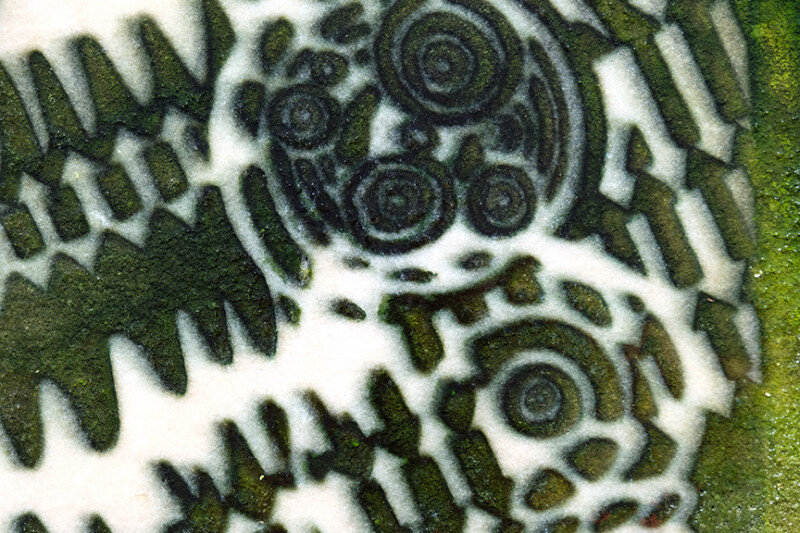
Wave, Temperature, and Frequency (W.T.F.) Interference, cyanobacteria, microorganisms, water, synthetic felt
“Art cannot be separated from life. It is the expression of the greatest need of which life is capable, and we value art not because of the skilled product, but because of its revelation of a life’s experience.”
-Robert Henri-
October 2020- Underneath a billowing Florida cloudscape, microscopic organisms are forming a photosensitive graphic emulsion. They’re held by fifty gallons of water in a sun bleached black-plastic feed trough. This experimental combination of glassmaking, printmaking, photography, and biology rests on a white sandy pasture covered with bahia, sedge, and clover grass. The goal is to cultivate these microorganisms under a thin film of water and glass to produce a living photographic image.
The concept developed a few years ago after discovering blue-green algae growing like polka-dots on a sheet of bubble-foil insulation. The foil was floating on top of an experimental tank as a sunshield helping to protect subaquatic plant roots from algal growth. While the foil did its job underwater, algae grew prolifically on the wet surfaces exposed to sunlight. Seeing it grow in a polka-dot like pattern began a long series of peculiar experiments and research in a cross disciplinary form of glass, printmaking, photography, and biology. Working at UrbanGlass with artists: Morgan Madison, Rachel Rader, Dorie Guthrie, Amy Lemaire, and Ben Wright, we were able to develop a specific glass technology for culturing graphic imagery with algae. The process works by exposing a cyanobacteria seeded substrate to light by using a transparent glass plate prepared with an image. The plate is made by printing black powdered glass onto clear glass, which is then kiln formed into a high relief, chemically inert image for culturing photosensitive bacteria.
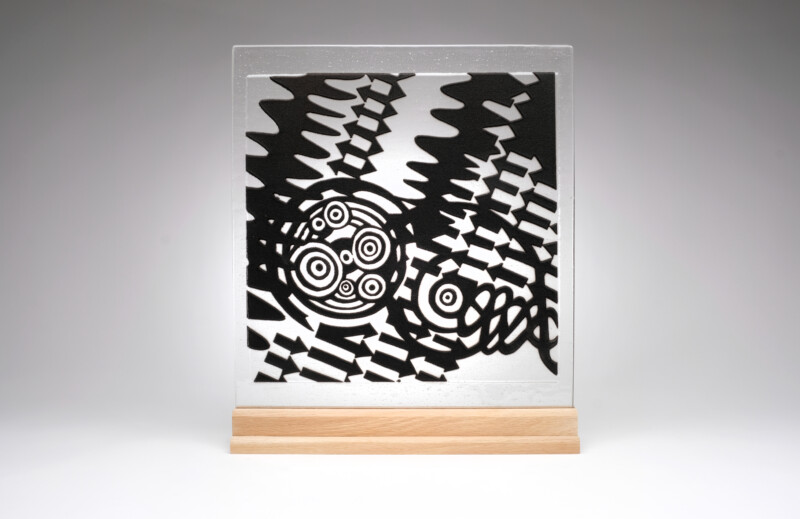
W.T.F. Interference, P.I.G. image plate – kiln formed glass, 17 x 18.5 inches
Channels formed between the printed layers of glass become bio-reaction cells where bacteria can grow. The process is carried out by feeding water, dissolved organic carbon (DOC), and inorganic mineral salts, to cyanobacteria growing underneath the plate. As light passes through areas of transparency (much like a film negative) bacteria is able to photosynthesize inside the bio-reaction cells and colonize into graphic shapes on a textile substrate. While it’s not exactly an instant snapshot, the resulting image is made by millions of organisms living together in symbiosis.
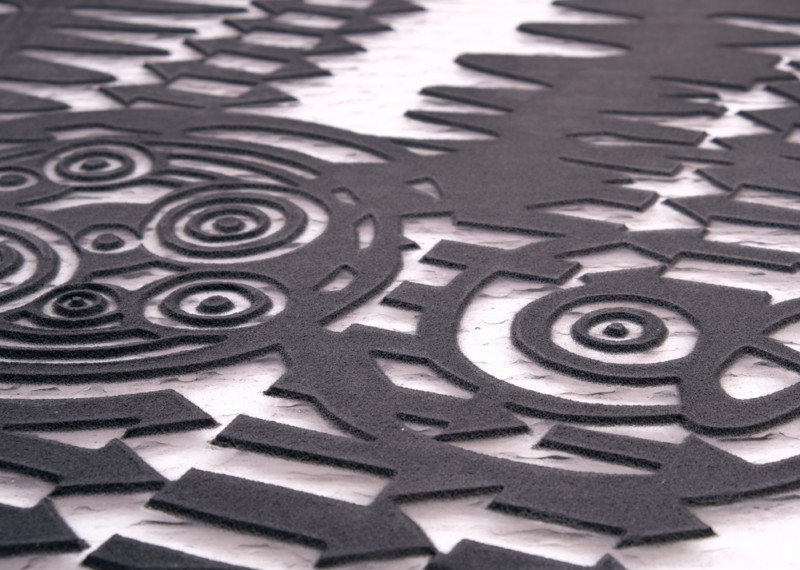
W.T.F. Interference, kiln formed glass, 17 x 18.5 inches
The pH cycle of the system, changes throughout the day like a clock. It’s one example of water’s sponge like qualities, absorbing chemicals and solar energy as plants consume carbon dioxide (CO2) for photosynthesis. Overnight, plants and bacteria metabolize stored photosynthetic sugars by burning them with oxygen thereby producing CO2. This nocturnal cellular respiration produces carbonic acid through a reaction of CO2 gas being dissolved in water. The lightly carbonated water lowers the pH, and the dissolved oxygen (DO) levels are lower, too. In the morning, plants begin reabsorbing the CO2 back into their tissue (as photosynthesis takes place) gradually raising the pH, and DO over the course of the day. Tracking this chemical effect forms a sine wave of data often referred to as bicarbonate buffering.
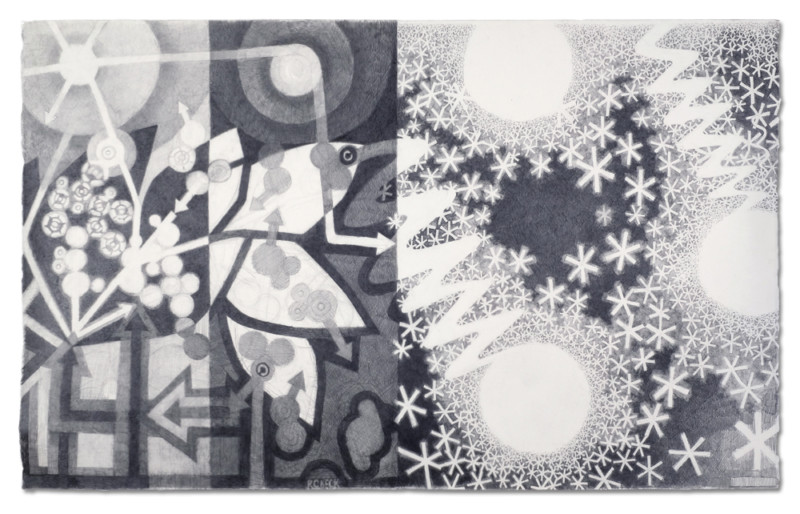
AM vs. PM, Wave Particles, graphite on paper, 30 x 42 inches
While I have observed bicarbonate buffering in small closed tank systems, this experiment is in the wide open and more like a pond. The water level is maintained by rainfall, which is for the most part free of any DOC. The appropriate nutrient levels were achieved by dosing the system with human urine and chelated iron. Measurements of the total dissolved solids (TDS) and pH helped establish the chemistry needed to jumpstart a baseline ecology. Water from the 50 gallon trough circulates through a white plastic photochemical processing tray where the glass plate and imaging substrate rests in slowly moving shallow water.
Nutrients were added after heavy rains to help the system grow and mature into a more homeorrhetic state. Now it recycles and maintains its chemistry through bicarbonate buffering. The symbiosis formed between the organisms and their aquatic habitat maintains an ecological dynamic as it continues to grow, divide, devour, and be devoured by the system in play. As long as there is water, light, and favorable atmospheric conditions, it should persist in a constant state of metamorphosis.
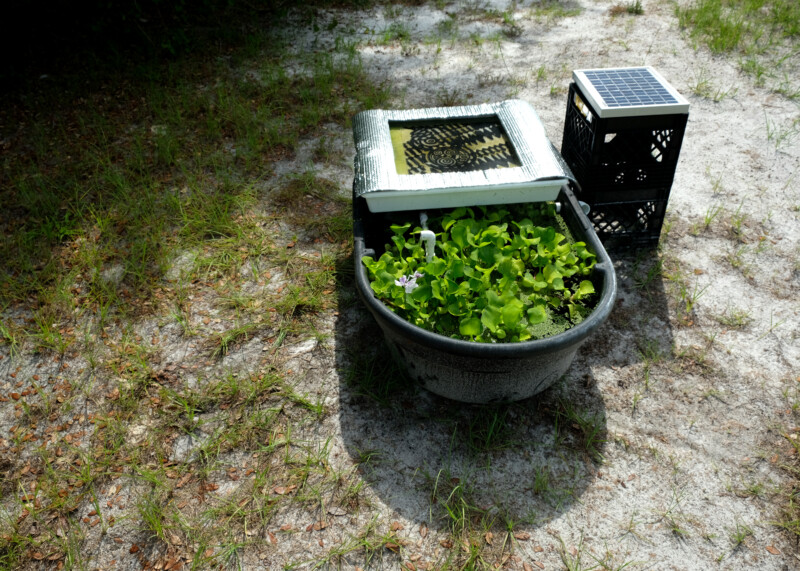
Photosynthetic Image Generator with W.T.F. Interference
Growing bacteria with any sense of graphic integrity is a challenge. Culture changes over time. And why should it matter, what’s the point of growing imagery anyway? Looking to Earth, we see the aesthetics of life all around, and in its metamorphosis we find sustenance, experience, creativity, and knowledge. The how and why of it seems more important than ever; increasing habitat and biodiversity supports environmental stability by working with biologically constructive processes and materials. Hopefully this project may lead to many more discoveries, and creative relationships aside of this graphic application.
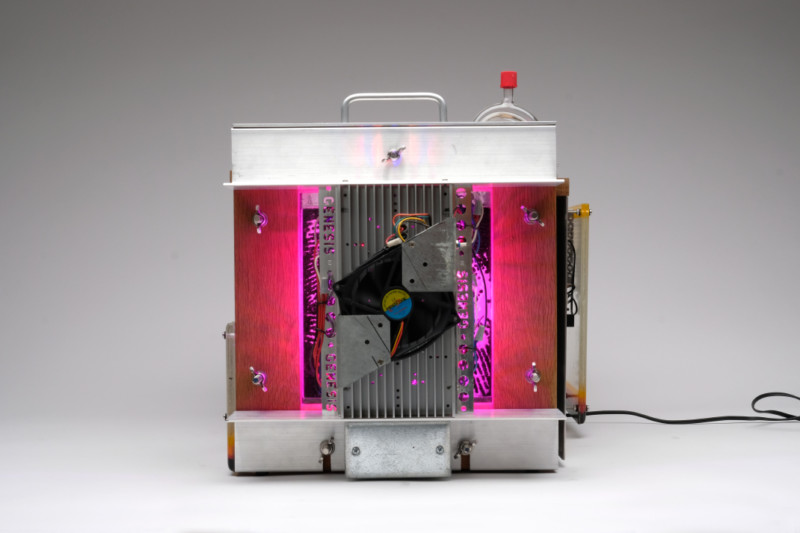
Photosynthetic Image Generator, vertical process tank, 16 x 20 x 30 inches
What began as a search for alternative biological adaptations to traditional media has become a persistence of life, versus the production or preservation of a product. Photosynthetic imaging is only one idea among an endless sea of possibilities, and all we have learned has not even come close to scratching the surface. This process will never get old. It’s alive, self-replicating, self-regulating, and builds habitat as it develops. It fills gaps in life, restores faith in dreams, and hopefully reveals not just one life’s experience, but rather, celebrates its many forms.
This project was made possible by UrbanGlass, Ben Write, Morgan Madison, Rachel Rader, Amy Lemaire, Dorie Guthrie, and Sarah Max Beck.
